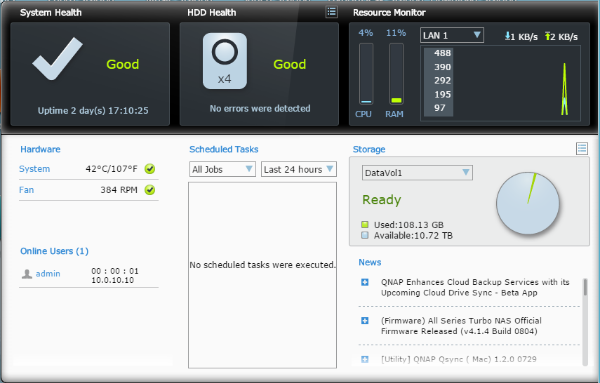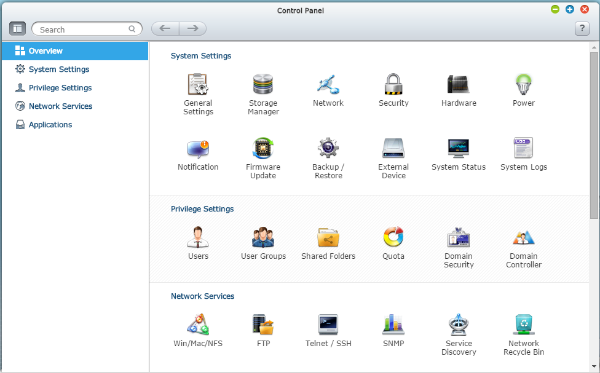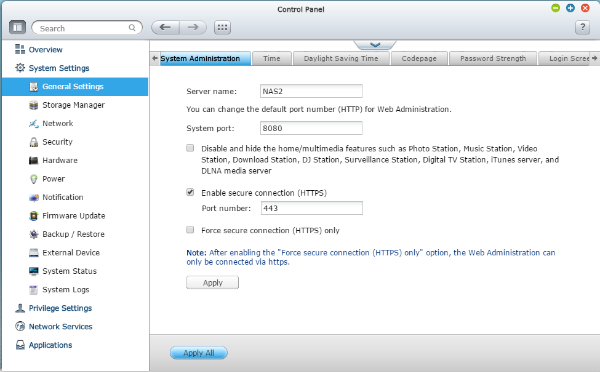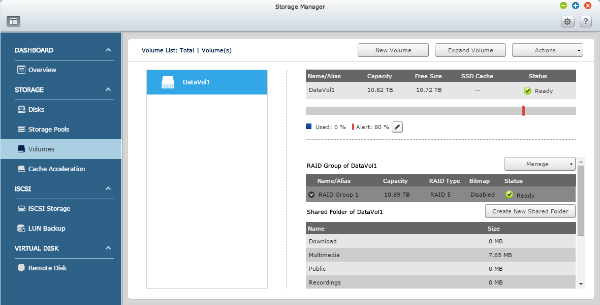QNAP TS-451+ NAS Review
Why you can trust Tom's Hardware
Software
Features
| Header Cell - Column 0 | QNAP TS-451+ |
|---|---|
| Operating System | QTS 4.2 (embedded Linux) |
| Client OS Support | Windows 8 (32 & 64-bit), 7 (32 & 64-bit), Vista, XP, Server 2012 R2 / 2012 / 2008 R2 / 2003Apple Mac OS XLinux & UNIX |
| Supported Browsers | Microsoft Internet Explorer 10+Mozilla Firefox 8+Apple Safari 4+Google Chrome |
| Multilingual Support | Chinese (Traditional & Simplified)CzechDanishDutchEnglishFinnishFrenchGermanGreekHungarianItalianJapaneseKoreanNorwegianPolishPortugueseRomanianRussianSpanishSwedishThaiTurkish |
| File System | Internal Hard Drive: EXT4External Hard Drive: EXT3, EXT4, NTFS, FAT32, HFS+ |
| Networking | TCP/IP (IPv4 & IPv6: Dual Stack)Dual Gigabit NICs with jumbo frame (fail-over, multi-IP settings, port trunking/NIC teaming)Service binding based on network interfacesProxy server (Squid Proxy Server via App Center)Proxy clientDHCP client, DHCP serverProtocols: CIFS/SMB, AFP (v3.3), NFS(v3), FTP, FTPS, SFTP, TFTP, HTTP(S), Telnet, SSH, iSCSI, SNMP, SMTP, and SMSCUPnP & Bonjour DiscoveryUSB Wi-Fi Adapter Support |
| Security | Network access protection with auto-blocking: SSH, Telnet, HTTP(S), FTP, CIFS/SMB, AFPCIFS host access control for shared foldersFIPS 140-2 validated AES 256-bit volume-based and shared folder data encryption*AES 256-bit external drive encryption*Importable SSL certificatesInstant alert via E-mail, SMS, beep, and push notification service2-step verification* The data encryption functions may not be available in accordance with the legislative restrictions of some countries. |
| Storage Management | QNAP flexible Volume/LUN with thin provisioning and space reclaimRAID 0,1, 5, 5 + hot spare, 6, 10Supports storage pools*Supports snapshots (4GB System RAM required)Supports Volume/LUN snapshot (Max 256 snapshots)Snapshot managerSnapshot cloneSnapshot vaultSnapshot replicaSnapshot agent for Windows VSS and VMwareOnline volume expansionOnline storage pool expansionOnline RAID capacity expansion and online RAID level migrationSMART data migrationStorage expansion via a QNAP UX-500P/UX-800P expansion unitJBOD enclosure roamingSSD read-only/read-write cacheBad block scan and hard drive S.M.A.R.T.Bad block recoveryRAID recoveryBitmap support |
| Power Management | Wake on LANInternal hard drive standby modeScheduled power on/offAutomatic power on after power recoveryUSB and network UPS support with SNMP managementSystem sleep mode (S3) |
| Access Right Management | Batch users creationImport/Export usersUser quota managementLocal user access control for CIFS, AFP, FTP, and WebDAVApplication access control for Photo Station, Music Station, Video Station, and File StationSubfolder permissions support for CIFS/SMB, AFP, FTP, and File Station |
| Transcode Management | Transcode video files to 240p, 360p, 480p, 720p and 1080p resolutionAutomatic video transcoding for watched foldersHardware accelerated transcoding supportEmbed subtitles into videos for background transcoding |
| Domain Authentication Integration | Microsoft Active Directory (AD) & Domain Controller supportLDAP server, LDAP clientDomain users login via CIFS/SMB, AFP, FTP, and File Station |
| myQNAPcloud Service | Private cloud storage and sharingFree host name registration (DDNS)Auto router configuration (via UPnP)Web-based file manager with HTTPS 2048-bit encryptionCloudLink for remote access without complicated router setupmyQNAPcloud connect for easy VPN connection (Windows VPN utility) |
| Qsync | Syncs files among multiple devices with SSL supportSelective synchronization for syncing specific folders onlyUse team folders as a file center for greater team collaboration (maximum sync tasks: 32)Shares files by links via emailPolicy settings for conflicted files and file type filter supportVersion control: up to 64 versionsIncremental synchronization for HDD space savingSupports Windows & Mac OS |
| Web Administration | Smart Fan ControlDynamic DNS (DDNS)SNMP (v2 & v3)Resource monitorNetwork recycle bin for file deletion via CIFS/SMB, AFP, and File StationAutomatic CleanupFile Type FilterComprehensive logs (events & connection)Syslog client/serverSystem settings backup and restoreRestore to factory defaultMobile app: Qmanager for remote system monitoring & management |
QNAP recently released QTS 4.2, its latest operating system. In it, we find support for QNAP's new Container Station, Qsearch function and various incremental updates for existing features. You can read more about QTS 4.2 on the operating system's microsite.
Feature Apps
| Header Cell - Column 0 | QNAP TS-451+ |
|---|---|
| File Server | File sharing across Windows, Mac, and Linux/UNIXWindows ACLAdvanced folder permission for CIFS/SMB, AFP, FTPShared folder aggregation (CIFS/SMB) |
| FTP Server | FTP over SSL/TLS (Explicit)FXP supportPassive FTP port range control |
| File Station | Supports ISO mounting (Up to 256 ISO files)Supports thumbnail display of multimedia filesSupports sharing download links and upload linksDrag-n-drop files via Google Chrome and Mozilla FirefoxFile compression (ZIP or 7z)Creation of and sending download links for sharing public files with expiration time and password protectionSupport for displaying subtitles (*.SRT, UTF-8 format)Support slideshow playback in media viewerMobile App: Qfile for file browsing and management |
| Backup Station | Remote replication server (over rsync)Real-time remote replication (RTRR) to another QNAP NAS or FTP serverWorks as both RTRR server & client with bandwidth controlReal-time & scheduled backupEncryption, compression, file filters, and transfer rate limitationsEncrypted replication between QNAP NAS serversDesktop backup with QNAP NetBak Replicator for WindowsApple Time Machine backup supportData backup to multiple external storage devicesSynchronizes with cloud storage: Amazon S3, ElephantDrive, DropboxThird party backup software support: Veeam backup & replication, Acronis True Image, Arcserve backup, emc retrospect, Symantec Backup Exec, etc |
| Print Server | Max. number of printers: 3Support for Internet Printing ProtocolPrint job display and managementIP-based and domain name-based privilege control |
| Cloud Backup Station | Amazon S3Amazon GlacierWebdev-based cloud storageMicrosoft AzureOpen Stack |
| HD (HybridDesk) Station 3.0 | Playback videos, music, photos on TV with Kodi via HDMIWatch various online content such as YouTube, Flickr, Picasa, Shoutcast, etc.Web browsers (Chrome, Firefox)Supports multi-lingual keyboard, input and mouseSupports QNAP Qremote app and the official KODI remote appSupports user login permissionsA variety of applications are available including Skype, Plex, and moreNote:- The playback and quality of some video files may be affected by the system's CPU and GPU decoding abilities.- Up to 7.1 channel audio pass-through is supported |
| Virtualization Station | Supports creating one Virtual Machine (VM) to run an operating system such as Windows, Linux, and UnixVM import from Virtual AppliancesVM export into a virtual appliance in OVF / QVM formatVM clone & snapshotHTML5-based shared remote console |
| Storage Plug & Connect | Creating and mapping shared folders using QNAP Windows QfinderCreation of and connection to iSCSI targets/LUN |
| iSCSI (IP SAN) | iSCSI target with multi-LUNs per target (Up to 256 targets/LUNs combined)Support for LUN mapping & maskingOnline LUN capacity expansionSupport for SPC-3 persistent reservationSupport for MPIO & MC/SiSCSI LUN backup, one-time snapshot, and restorationiSCSI connection and management by QNAP Windows QfinderVirtual disk drive (via iSCSI initiator)Stack chaining masterMax No. of virtual disk drives: 8 |
| Surveillance Station | Supports over 3,000 IP camerasIncludes 4 free camera licenses, up to 40 camera channels via additional license purchaseInstant playback to check recent eventsOnline editing to change cameras when in live viewVisual aid by using e-mapsPlayback and speed control by shuttle barVideo preview using playback timelineIntelligent Video Analytics (IVA) for advanced video searchSurveillance client for MacMobile surveillance app: Vmobile (iOS and Android)Mobile recording app: Vcam (iOS and Android) |
| VPN Server | Secure remote access: PPTP & OpenVPN VPN servicesMax number of clients: 30 |
| VPN Client | Supported VPN protocols: PPTP & OpenVPN servicesPPTP Authentication: PAP, CHAP, MS-CHAP, MS-CHAPv2PPTP Encryption: None, AES 40/128 bit, AES 256 bitOpenVPN Encryption: None, AES 40/128 bit, AES 256 bitTransmission package monitorOpenVPN port controlOpenVPN link compression |
| App Center | Over 100 official and community software add-ons like Photo Station, Music Station, Video Station, DLNA server, Notes Station, Signage Station, Airplay/Chromecast, and more |
Interface
There are so many software features that we could write an entire article just on the operating system and what's inside. In fact, we plan to publish comprehensive feature stories covering NAS operating systems and their GUIs in the future. For now, there are more native features and optional add-ons than we can introduce in a single device review.
There are hundreds of pages in the QNAP QTS operating system, but they all originate from the main screen. The icons are similar to what you find in Android; you can move and re-position them across the three default pages. Of course, you can also add and remove icons as needed.
The health check feature in the lower-right corner of the dashboard opens to what we see here. It provides a quick way to catch the latest QNAP software news, see details about firmware updates and view the system's status. You can monitor the storage array and CPU, in addition to keeping an eye on memory usage and network traffic. Another pane shows if other users are logged in to the system; you don't want to update firmware or restart the NAS if someone else is using a shared file from a remote location.
Before we even get into the applications, let's look at the system's many configurable features. Everything comes set up from QNAP to be completely usable. But you can easily change the options to create a more customized experience.
For instance, disable and hide all of the home/multimedia functions by clicking a single check-box. This helps save processing cycles and system memory if those capabilities aren't needed.
Get Tom's Hardware's best news and in-depth reviews, straight to your inbox.
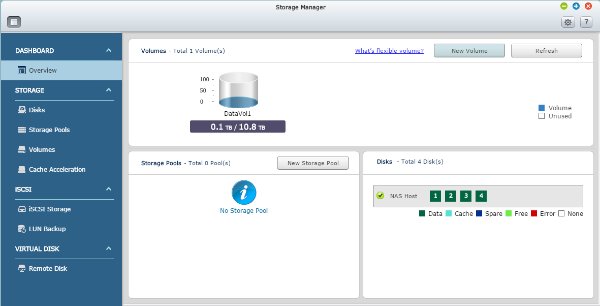

In QTS' Storage Manager, you can build arrays either in volumes or by pools of disks. The latter option, introduced a few years ago, allows the appliance to tackle storage like an enterprise-class SAN. For example, one part of a drive may be a member of a RAID 0 array, while another section is part of a RAID 5 array.
When we review QNAP NAS appliances, we use the single-volume option. Systems with seven drive bays and less are tested in RAID 5, while systems with eight or more disks are tested in RAID 6.
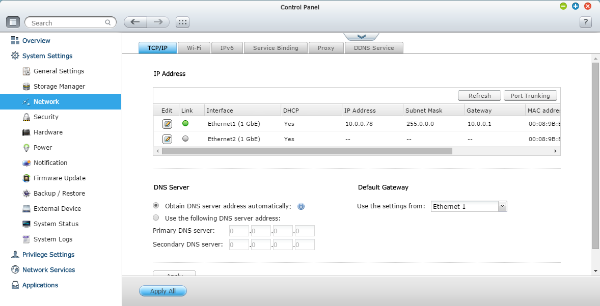
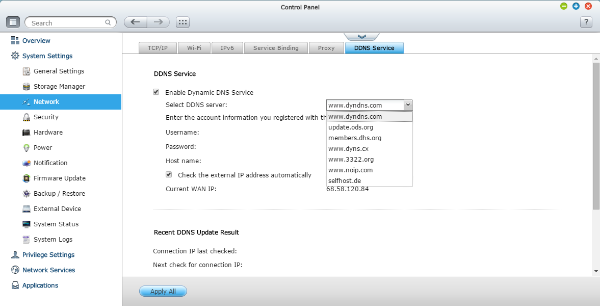
You get a lot of networking options, too. QNAP facilitates several modes of network teaming, including 802.11ad link aggregation. And there are a few ways to connect to the system from outside of your intranet: it's accessible from QNAP's cloud feature, a free service through a specialized website, or through a third-party DDNS service.

Chris Ramseyer was a senior contributing editor for Tom's Hardware. He tested and reviewed consumer storage.
-
RedJaron ReplyThis is the new breed of network-attached devices that extends beyond storage. Many new home and small office QNAP systems fall into this category. Nobody has coined an official term for these systems, but someone really should. Continuing to call them NAS fails to capture everything they're capable of.
Hmmm, well first, the problem is that NAS on its own was a bit of a misnomer in a lot of cases. The idea of "Network Attached Storage" is just talking about the storage itself, the drives, not the machine that actually hosts or manages them. It works fine for describing an external hard drive plugged into a router over USB, but any time you have a dedicated device for hosting and managing a storage array, the idea of NAS alone was no longer sufficient for it. Even if it didn't have the media abilities this one did, if it had its own OS, if you could remote into to and configure the storage system, if it was more or less autonomous, that's more a server than just NAS array.
NAS Server, or NASS is probably too similar and would be confusing. Network Attached Managed Storage or Networked Attached Hosted Storage would be more accurate, though "hosted" has cloud storage connotations so that may not be great. You could call them NARCs for network attached RAID controllers/computers. But in reality these things are servers. A Celeron is far beyond a simple hard drive or RAID controller and QNAP's OS is far beyond a simple router firmware. These are network storage servers, or simple network storage servers if you want to differentiate them from from the big, expensive server clusters. If you want to keep it close to NAS, I'd call it a NARS ( network attached RAID server ). -
blazorthon ReplyHmmm, well first, the problem is that NAS on its own was a bit of a misnomer in a lot of cases. The idea of "Network Attached Storage" is just talking about the storage itself, the drives, not the machine that actually hosts or manages them. It works fine for describing an external hard drive plugged into a router over USB, but any time you have a dedicated device for hosting and managing a storage array, the idea of NAS alone was no longer sufficient for it. Even if it didn't have the media abilities this one did, if it had its own OS, if you could remote into to and configure the storage system, if it was more or less autonomous, that's more a server than just NAS array.
NAS Server, or NASS is probably too similar and would be confusing. Network Attached Managed Storage or Networked Attached Hosted Storage would be more accurate, though "hosted" has cloud storage connotations so that may not be great. You could call them NARCs for network attached RAID controllers/computers. But in reality these things are servers. A Celeron is far beyond a simple hard drive or RAID controller and QNAP's OS is far beyond a simple router firmware. These are network storage servers, or simple network storage servers if you want to differentiate them from from the big, expensive server clusters. If you want to keep it close to NAS, I'd call it a NARS ( network attached RAID server ).
NARC has my vote. -
palladin9479 ReplyThis is the new breed of network-attached devices that extends beyond storage. Many new home and small office QNAP systems fall into this category. Nobody has coined an official term for these systems, but someone really should. Continuing to call them NAS fails to capture everything they're capable of.
We do have a name for it. It's a very old name with a distinguished history, it's known as "File Server". This is no different then having Unix / Linux / NT installed on a server and then exporting storage to a local network in whatever language / protocol is necessary. Hiding the OS from the customer nor automating the maintenance of the File Server does not change it's designation or purpose. Further if we wanted to install additional services onto our File Server it now becomes an Application Server and since it's an All-In-One device we could just call it a Server. Congratulations on reinventing a 1980's concept.
As for iSCSI in a home environment, just say no. There is a reason it's not used. Without jumbo frames, and a dedicated VLAN / QoS you are going to be shredding your network I/O. Each 4K I/O block gets broken into three separate Ethernet frames and blasted out across the switch where it competes with every other form of traffic for bandwidth and network I/O. It's heard by the distant end, reassembled in the network buffer, read and then another request is sent out, all without compression or any form of traffic shaping. It's perfectly fine for lab and experimental work but absolutely atrocious for real world work loads. If you have to store and execute data remotely then use SMB via a mounted drive letter or even a NTFS junction via mklink.
mklink /d C:\FolderToInstallStuff \\NASServer\\SMBShareFolder
Will create an entry in the NTFS file table that looks like a folder to everything, except the file storage subsystem, any file operations directed to that folder will instead be redirected to the remote SMB server. Applications will act exactly the same but without having to deal with the issues of having to abstract a block level device over a home network connection. Let the OS do it's job with optimizing network file I/O.
Side note about performance. The real difference between file level and block level access is where the onus of file system management takes place. With file level the remote file server is responsible and must spend CPU cycles and memory for caching the data, on block level your local machine is responsible for doing it. Since local machines tend to have more CPU / memory iSCSI would win in a back-to-back configuration (Client <-> Server) with nothing else happening on the switch, in which case might as well use a cross-over cable. The moment you start placing additional traffic on the network that the iSCSI packets now need to compete with, this starts to change as iSCSI wasn't designed to fight with other traffic nor is the client computer even aware that it has to. Also once your iSCSI storage manager has enough CPU power and memory to effectively manage it's own file shares, that advantage of iSCSI melts away and the performance swings in the other direction, especially as file services are available to all incoming clients while iSCSI is only available to the initiator.
Since these QNAP devices have decently powerful x86 CPU's with generous amounts of memory host side resource contention won't be a problem. It's having to shove 4K random I/O requests over a 1500MTU pipe on a general purpose VLAN with all the other traffic that's the problem. The real solution is local storage for data intensive programs and remote storage for shared media files. SATA storage is cheap, no need to reinvent the wheel in the home. -
fraserw Stupid question: Can this box support local mount through usb3 while still allowing the drive to be network mounted to other machines?Reply -
VVV850 You mention HDMI port but never test what you can do with it. How able is the NAS as a media player or as a VM Player. You only approach the same old statistics of a file server even though you mention that it is a lot more then that...Reply -
CRamseyer ReplyStupid question: Can this box support local mount through usb3 while still allowing the drive to be network mounted to other machines?
No, this system doesn't have any direct attach function outside of Ethernet. -
heffeque ReplyYou mention HDMI port but never test what you can do with it. How able is the NAS as a media player or as a VM Player. You only approach the same old statistics of a file server even though you mention that it is a lot more then that...
My thoughts exactly!Also, QNAP has a very VERY good OS. Many Synology purists would be surprised with how good QNAP has gotten. -
CRamseyer I think QNAP has the best on the market right now. Admittedly I haven't spent a lot of time with Thecus' new OS 7 but I plan to this weekend.Reply
I'll also have time to move the racks over to a dedicated server closet. On the way I can shoot some images for the upcoming How We Test NAS article. -
ttocsmij ReplyThis is the new breed of network-attached devices that extends beyond storage. Many new home and small office QNAP systems fall into this category. Nobody has coined an official term for these systems, but someone really should. Continuing to call them NAS fails to capture everything they're capable of.
We do have a name for it. It's a very old name with a distinguished history, it's known as "File Server". This is no different then having Unix / Linux / NT installed on a server and then exporting storage to a local network in whatever language / protocol is necessary. Hiding the OS from the customer nor automating the maintenance of the File Server does not change it's designation or purpose. Further if we wanted to install additional services onto our File Server it now becomes an Application Server and since it's an All-In-One device we could just call it a Server. Congratulations on reinventing a 1980's concept.
As for iSCSI in a home environment, just say no. There is a reason it's not used. ...
... especially as file services are available to all incoming clients while iSCSI is only available to the initiator.
Since these QNAP devices have decently powerful x86 CPU's with generous amounts of memory host side resource contention won't be a problem. It's having to shove 4K random I/O requests over a 1500MTU pipe on a general purpose VLAN with all the other traffic that's the problem. The real solution is local storage for data intensive programs and remote storage for shared media files. SATA storage is cheap, no need to reinvent the wheel in the home.
I'm not sure what palladin9479 is trying to say here. Is he against QNAP, NAS for home, or what, exactly?!
I need a place to backup the three computers (wireless, wireless, wired) we use here at the house and this sounds like the ticket. Am I wrong? Should I be looking at something different? I was just thinking I could connect an NAS to an Ethernet port on the wireless router and start setting things up.
-
CRamseyer You will be fine with a QNAP system attached to your existing network. Palladin9479 was referring to iSCSI used in the home.Reply
iSCSI is just a way of adding storage one or more of your computers. It has some advantages over SMB shares. When attached (through software) to your computer the share shows up as a drive letter and the system sees the share as local storage.
You can do the same thing with a network share by mapping a share as a drive letter but not all software sees the network mapped drive as local storage. If you plan to install programs on the NAS rather than your C: drive the network mapped drive can be a problem. With iSCSI the connection is always there. Mapped drives don't offer the same same reliability or security as iSCSI.

